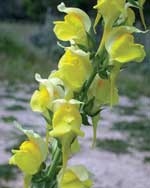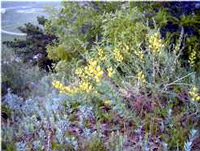Dalmatian Toadflax
Linaria genistifolia ssp. dalmatica
Keys to Identification
- Dalmatian toadflax is a member of the Figwort family. It was introduced as an ornamental from Europe, and is now rapidly invading dry rangeland from 5,000 to 6,500 feet. It is a creeping perennial that closely resembles yellow toadflax. The leaves are waxy, heart-shaped, and clasp the stem. The stems are from 2 to 4 feet tall. The flowers are snapdragon-shaped, bright yellow, sometimes with orange centers.
- Dalmatian toadflax is especially well adapted to arid sites and can spread rapidly once established. Because of its deep, extensive root system, waxy leaf, and heavy seed production, this plant can be difficult to manage.
This information courtesy of the Colorado Natural Areas Program.
Family
Figwort (Scrophulariaceae)
Other Names
Broad-leaved toadflax, wild snapdragon
USDA Code
LIDAM
Legal Status
Colorado Noxious Weed List B
Identification
Lifecycle
Perennial
Growth form
Forb
Flower
Flowers are borne in loose, elongate, terminal racemes. Flowers are bright yellow and resemble snapdragons. May-Aug.
Seeds/Fruit
Fruits are egg-shaped to nearly round capsules. Seeds are sharply angular, and slightly winged.
Leaves
Leaves are broad, ovate to ovate-lanceolate, and are alternate, generally clasping but crowded.
Stems
Mature plants are up to 3 ft tall. A single toadflax plant contains from 1-25 vertical, floral stems. which are thick-walled and somewhat woody.
Roots
The taproot may penetrate 3 ft into the soil. Horizontal roots may grow to be several yards long, and can develop adventitious buds that may form independent plants.
Seedling
No information available.
Similar Species
Exotics
Yellow toadflax (Linaria vulgaris) is similar in appearance, but has more linear pointed leaves, and is generally a smaller plant.
Natives
None known.
Impacts
Agricultural
Low-till cultivation practices have contributed to the resurgence of toadflax populations on agricultural lands (McClay 1992). Dalmatian toadflax contains a glucoside, a quinoline alkaloid, and peganine which make it toxic to livestock (Rees et al. 1996). However, Dalmatian toadflax is generally considered unpalatable, and reports of livestock poisonings are rare.
Ecological
Dalmatian toadflax is a persistent, aggressive invader and capable of forming colonies through adventitious buds from creeping root systems. These colonies can push out native grasses and other perennials, thereby altering the species composition of natural communities. New infestations of Dalmatian toadflax can occur in naturally occurring disturbances or in small openings in pristine or excellent-condition rangeland (Lajeunesse 1999). Dalmatian toadflax can rapidly colonize open sites. It is most commonly found along roadsides, fences, rangelands, croplands, clear cuts, and pastures. Disturbed or cultivated ground is a prime candidate for colonization. Toadflax can significantly reduce crop yields and stress native communities. In one study, toadflax-free plots produced 2.5 times more grass than plots where toadflax was present (Robocker 1974). The seedlings of toadflax are considered ineffective competitors for soil moisture with established perennials and winter annuals (Morishita 1991). However, once established both species of toadflax suppress other vegetation mainly by intense competition for limited soil water. Mature plants are particularly competitive with winter annuals and shallow-rooted perennials (Robocker 1974).
Human
No information available.
Habitat and Distribution
General requirements
Dalmatian toadflax can adapt its growth to fit a wide range of environmental conditions, and is tolerant of low temperatures and coarse-textured soils.
Distribution
In Colorado, Dalmatian toadflax is commonly found between 5,000 to 6,500 feet in oak, aspen, sagebrush, mountain brush, and riparian communities. It can be found growing up to 9,000 feet (A. Green)
Historical
Native to Mediterranean region.
Biology/Ecology
Lifecycle
Spring emergence occurs about mid-April and depends primarily on temperature. During the first year the plant forms a rosette and develops a deep root system. Prostrate stems emerge in September and produce egg-shaped leaves. Prostrate stems are tolerant to freezing and are associated with floral stem production the following year (Robocker 1974). The strong upright floral stems that characterize mature toadflax plants develop after a winter’s dormancy, and emerge about the same time as new seedlings in mid-April. A single plant will produce from 1-25 floral stems. Flowering occurs from May-August and seeds mature from July-September. Dalmatian toadflax can also reproduce vegetatively. Stems develop from adventitious buds on primary and lateral roots. Vegetative reproduction from root buds can occur as early as 2-3 weeks after germination, and is possible from root fragments as short as 1 cm long (Zimmerman 1996). These buds can grow their own root and shoot systems, and become independent plants the next year. In addition to promoting growth, the large, deep, root systems of Dalmatian toadflax exploit water efficiently. The taproot may penetrate 3-4 feet into the soil and lateral roots may be 6-12 ft long. (periods of growth, emergence, bolting, flowering and seed production)
Mode of reproduction
By seeds and vegetatively.
Seed production
A mature Dalmatian toadflax can produce up to 500,000 seeds annually (Morishita 1991).
Seed bank
Seeds may remain viable in the soil for up to ten years.
References
Carpenter, A.T. and T.A. Murray. 1998. Element Stewardship Abstract for Linaria dalmatica. The Nature Conservancy, Wildland Weed Program. Internet: 1/21/99. Available: http://tncweeds.ucdavis.edu/esadocs.html
Lajeunesse, S. 1999. Dalmatian and yellow toadflax. In: R.L. Sheley and J.K. Petroff (eds.) Biology and management of noxious rangeland weeds. Oregon State University Press, Corvallis. pp. 202-216.
McClay, A.S. 1992. Effects of Brachypterolus pulicarius (L.) (Coleoptera: Nitidulidae) on flowering and seed production of common toadflax. The Canadian Entomologist 124: 631-636.
Moroshita, D.W. 1991. Dalmatian toadflax, yellow toadflax, black henbane, and tansymustard: importance, distribution, and control. Pages 399-408 In: L.F. James, J.O. Evans, M.H. Ralphs, and R.D. Child (editors) Noxious range weeds. Westview Press, Boulder, San Francisco, and Oxford.
Robocker, W.C. 1974. Life history, ecology, and control of Dalmatian toadflax. Tech. Bull No. 79. Wash. Agric. Exp. Stn.
Zimmerman, J.A.C. 1996. Ecology and distribution of Linaria vulgaris (L.) Miller, Scrophulariaceae. USGS Biological Resources Division, Colorado Plateau Field Station-Flagstaff, Arizona. Internet. 01/14/98. Available: http://www.nbs.nau.edu/FNF/Vegetation/Exotics/linariatitle.html



